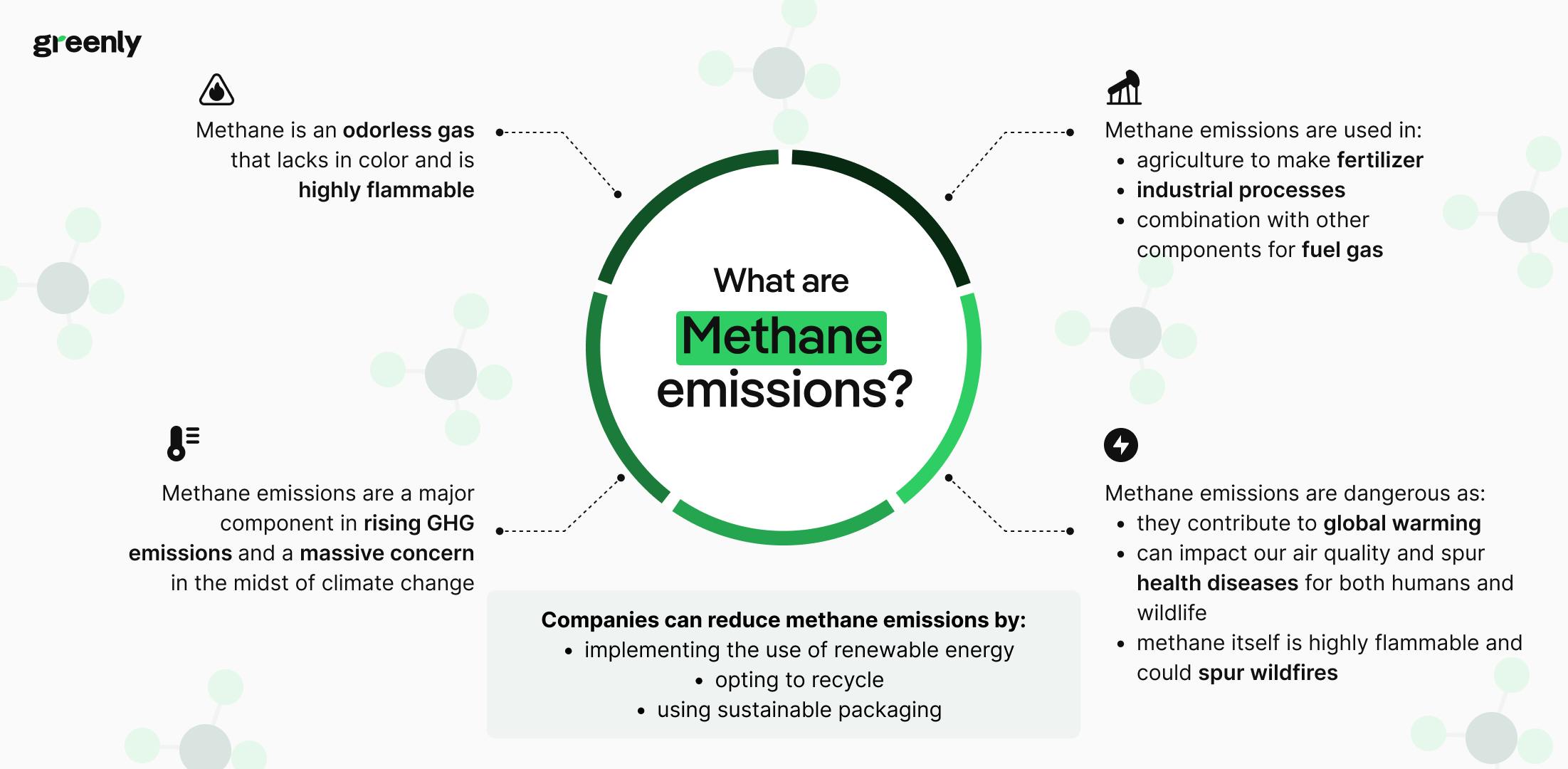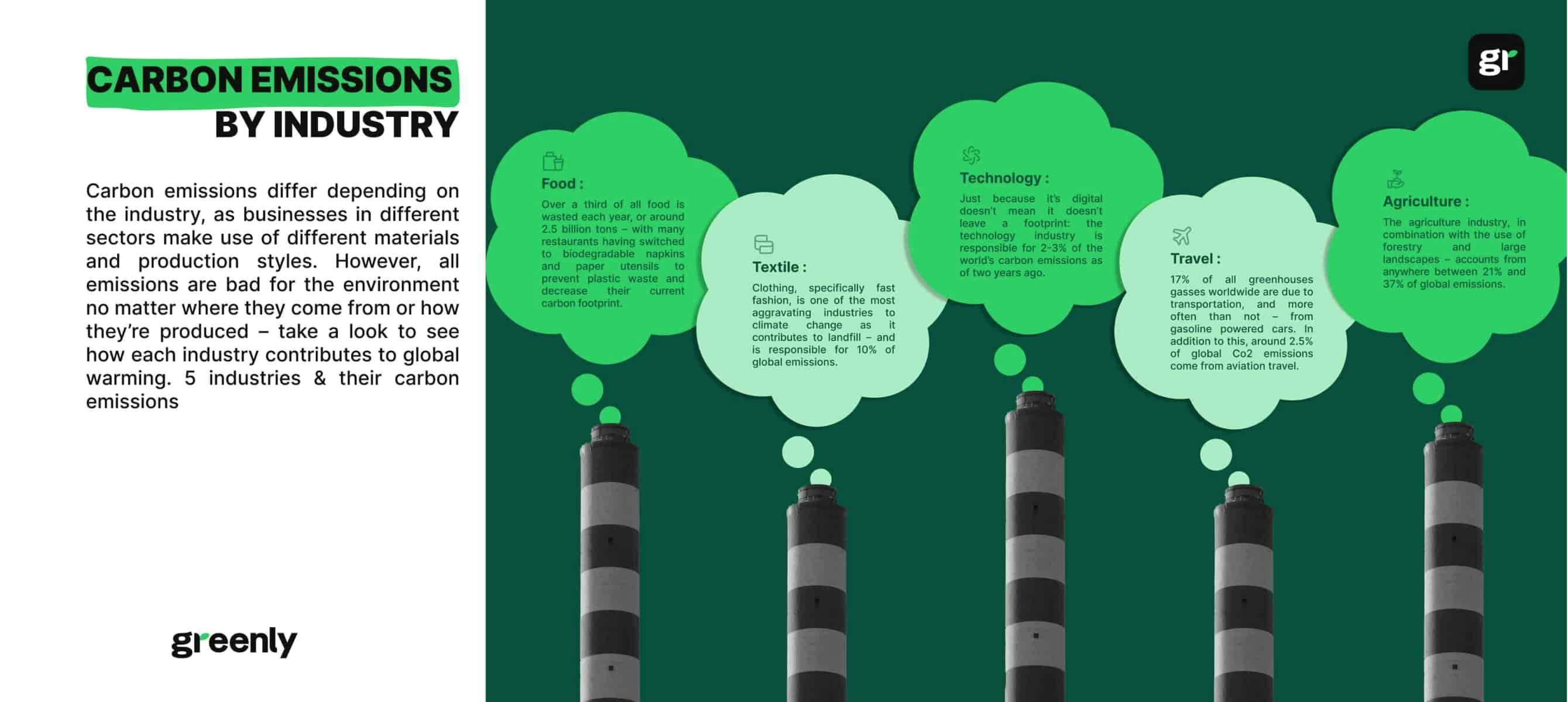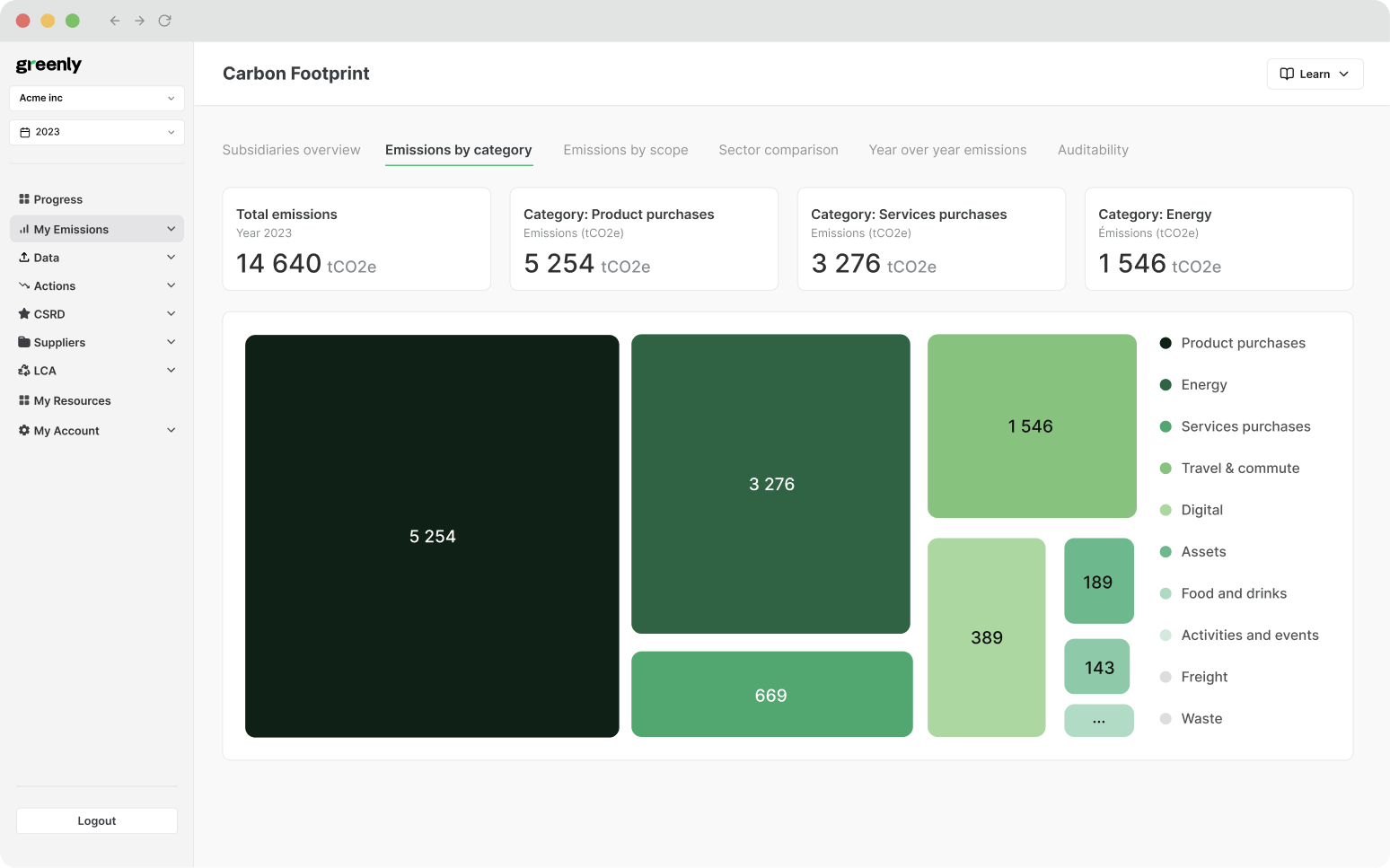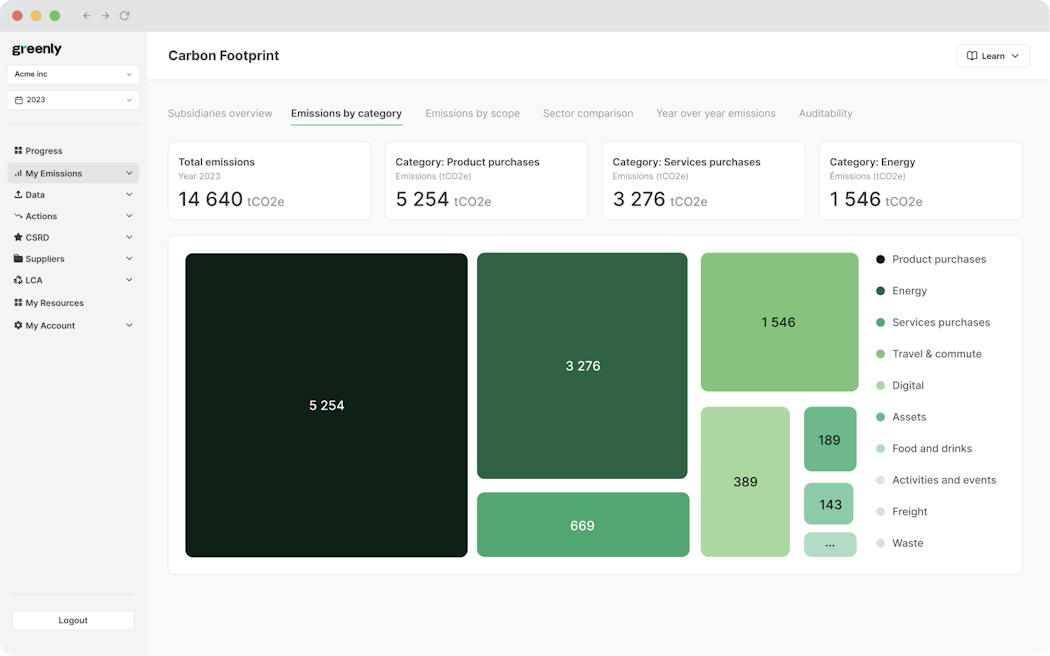
What are the 3 Pillars of Corporate Sustainability?
In this article, we'll explore what the 3 pillars of corporate responsibility are, why they're important, and how businesses can turn them into practical action.
ESG / CSR
Industries



In your personal life, you're probably trying to reduce your personal carbon footprint, whether it’s through flying less, eating local, consuming less meat, preventing food waste, shifting to vegan diet, buying sustainably sourced products, preferring public transportation, cycling to work, investing in an electric vehicle or bringing your own shopping bag to the supermarket.
But oftentimes, our professional activities can leave a much bigger carbon footprint than that of our personal lives. Therefore, the question is how to reduce carbon footprint (business), such as by opting for renewable energy and phasing out fossil fuels, in order to help in the fight against climate change?
We’ve put together this handy guide to help your business work towards decreasing its carbon footprint slowly and sustainably.
A carbon footprint refers to the amount of carbon dioxide released into the atmosphere following activities of an individual, organisation, or community – such as air travel, business operations, or even securing carbon intensive meats.
In 1896, a chemist named Svante Arrhenius ran various calculations and discovered that the carbon emissions coming from human activity were sizable enough to eventually cause global temperatures to rise through the greenhouse effect.
However, it wasn’t until about a hundred years later that we became conscious of carbon footprints, and started setting out to try to reduce them.
As a whole, a carbon footprint refers to the total measure of the greenhouse gas emissions (mainly carbon dioxide, but also gasses like methane and nitrous oxide) caused by a person’s or a business’s activity.
The interactive flip cards below (move your cursor over to flip them) will help you to better understand the components that make a up a carbon footprint:


A carbon footprint is expressed as carbon dioxide equivalent, measured in weight (kilograms, tons, megatons and so on), as defined by the Greenhouse Gas Protocol, the world's most widely used greenhouse gas accounting standard.
We can also assign carbon footprints to products, services, business activities, and individuals – essentially everything that exists or every activity responsible for carbon dioxide emissions. This can include bananas (118g or 4.16oz for each), emails (4g or 0.14oz each), and a Google search (0.2g or 0.007oz each).
The table below will illustrate additional common contributors to excessively large carbon footprints:
| Activity/Thing | Carbon Footprint Contribution |
|---|---|
| Driving a Gasoline-Powered Car | Emissions from burning fossil fuels contribute to high CO2 output. |
| Air Travel | Flights release significant amounts of CO2 into the atmosphere, especially long-haul flights. |
| Consuming Red Meat | Meat production, particularly beef, contributes to methane emissions and deforestation. |
| Using Disposable Plastics | Plastic production and waste contribute to greenhouse gas emissions during manufacturing and decomposition. |
| Unnecessary Energy Consumption | Using more energy than necessary for heating, cooling, and appliances results in more fossil fuel use. |
| Fast Fashion | Clothing manufacturing, dyeing processes, and the rapid turnover of trends lead to increased waste and emissions. |
| Deforestation | Clearing forests for agriculture or development reduces CO2 absorption and contributes to environmental degradation. |
| Food Waste | Food waste that decomposes in landfills emits methane, a potent greenhouse gas. |
| Overconsumption of Water | The energy used for water treatment, heating, and distribution adds to the carbon footprint. |
| Excessive Use of Single-Use Items | Packaging and single-use items, often made of plastic or non-recyclable materials, add to waste and pollution. |
Overall, measuring our carbon footprints can provide us with a clear universal metric for comparing and contrasting, and helps us work out where we can start to reduce greenhouse gas emissions – such as by pinpointing where we must reduce emissions, where we can implement the use of renewable energy sources, work towards using less energy, and more.

Working to reduce carbon emissions and your company's carbon footprint can help contribute to a healthier, more sustainable planet. More importantly, it can help to prevent the consequences of climate change, such as extreme weather events, food scarcity, water shortages, and more.
While many recognise the urgency of tackling climate change, businesses often struggle to prioritise and communicate their efforts to reduce carbon dioxide emissions – as global consumerism continues to take precedent over working towards or achieving net zero emissions in the 21st century.
Luckily, there are many reasons to start measuring and monitoring at your business’s carbon footprint, and many of them have nothing to do with the environment – meaning it could actually prove useful to the success of your business long-term.
Here's a breakdown of why working to reduce your carbon footprint footprint via efforts to save energy, employ fuel efficiency, use clean energy equipment, or follow the guidelines depicted by the Environmental Protection Agency could all prove worthwhile for your business:
Consumers are increasingly looking for socially and environmentally conscious brands, which means that if your company becomes opening to changing its business model – you could draw in both new customers and extend the loyalty of your existing clients.
In fact, a study by Havard in 2023 revealed that 44% of people recommending ESG products end up sharing it with over 10 people – meaning eco-friendly businesses are likely to become more popular through word of mouth alone. According to Harvard Business Review, conscious consumers made up 24% of U.S. customers in 2023, and if trends continue – Capital One estimates that 91% of customers will be shopping sustainably in 2025.
Making a commitment to reducing your carbon footprint (or even working towards net zero) is a smart way to attract younger talent.
In fact, 71% of employees would consider a pay cut to work for an employer whose values match their own. In addition to this, according to a survey conducted by Deloitte, purpose-driven companies are 40% more likely to retain their existing workforce.
If you’re concerned about hiring and keeping good employees, climate action and carbon footprint targets are great for your brand – as they can attract the right kind of talent to help encourage your company to both develop and maintain more sustainable practices.
Swapping a short car trip for a bike ride or walk reduces transportation emissions significantly.
Turning off lights, monitors, and electronics when not in use helps cut down on wasted energy.
Cutting back on single-use plastics at work prevents landfill waste and reduces manufacturing emissions.
Opting for meatless lunches, even once a week, significantly lowers your food-related carbon footprint.
Using digital tools over printing saves paper, reduces deforestation, and cuts emissions from paper production.
Taking buses or trains instead of driving alone helps reduce per-person emissions and traffic congestion.
Investors are increasingly looking to fund environmentally friendly companies, as sustainable companies are more bound to maintain their financial success in the coming years in conjunction with climate change and depleting resources.
This means that measuring, disclosing and reducing your carbon footprint is one way to demonstrate that you are actively committed to shaping a better planet for future generations, and inspires trust and transparency.
Furthermore, this can help to build a better relationship with your suppliers and stakeholders.
Working on your greenhouse gasses may not be an immediate opportunity to cut operational costs and save money, but going green can have a positive, long-term effect on your net profit – as implementing the use of things like solar panels or energy efficient technologies can help to reduce your business expenses over time.
Efforts to reduce tour company's carbon footprint that could also result in cost savings over time include:
As a whole, all of these benefits may not have occurred if your business hadn't started to prioritise its carbon footprint. Contrary to popular opinion, going green doesn’t have to mean more expensive.
In the end, working on your greenhouse gas emissions does require additional time and resources – but it’s an investment in your business’s future, and it’s not without returns as it could help your business to flourish over the long run.
In fact, the International Energy Agency (IEA) reported that efforts to substitute the use of fossil fuels in place of renewable energy was set to increase slightly by 4% in 2024, matching the all-time high in annual investment of about USD $660 billion achieved in 2022.
As a whole, all of these benefits may not have occurred if your business hadn't started to prioritise its carbon footprint. Contrary to popular opinion, going green doesn't have to mean more expensive. For example, according to the Solar Energy Industries Association (SEIA), businesses can save an estimated 75% on electricity expenses after implementing the use of solar panels.

At Greenly, we know that it feel overwhelming to get started – but we’ve got a simple three-step process that will guide you through from beginning to end. This will help you to effectively reduce your carbon footprint.
Here's how your company can get started in reducing your carbon emissions and footprint:
The first step to reduce your carbon footprint is figuring out how big your greenhouse gas emissions currently are – which will be contingent on your company's size and sector.
In fact, a carbon footprint measurement does more than tell you how much carbon you're responsible for — it also tells you which activities account for what percentage of your carbon emissions.
This granularity is crucial for the next step, because without knowing which activities are causing most of your greenhouse gases, it’s impossible to know the best place to start taking effective steps toward reducing emission.
This is where the real action comes in. Once you’ve got clear data on which business activities are the biggest contributors to your average carbon footprint, you can start to set clear and measurable goals for reducing it, and make a plan for what you’ll tackle first.
Finding quick and simple ways to drastically reduce your carbon footprint through concrete goals and actions a great way to start your sustainability journey. It allows for quick, quantifiable results, builds momentum, and boosts morale across the team. Once you’ve got a few successes under your belt, you can look at setting longer-term goals for reducing (and maybe even neutralising) your greenhouse gas emissions.
As we have already explained on our blog before, it’s impossible for your business to emit zero carbon – as we all emit carbon ourselves just by breathing (but don’t worry, your breath is technically net zero).
However, many businesses want to know the final step — once you’ve done all that you can (or even if you haven’t, but are working towards it), what else can you do to further reduce your business’s impact on the climate change?
The answer is offsetting, which is a way to compensate for your company’s carbon emissions by investing in projects that help prevent more carbon from entering the atmosphere (more on this below).
In others words, you should purchase carbon offsets to help compensate for the additional emissions your company will be unable to reduce on its own.

Calculating the carbon footprint of an entire business is no small task. Calculating the
There are three ways to go about measuring your company's carbon footprint: internally, externally, and digitally:
Calculating your business’s carbon footprint internally can be complicated and time-consuming. Most of the time, you’d need to hire a dedicated carbon accountant or even a team of carbon accountants, which can get expensive quickly.
If you’re just looking for a rough idea of your greenhouse gas emissions as a starting point, try using Greenly’s free carbon footprint calculator.
Some companies opt to hire environmental consulting firms to help them calculate and reduce their carbon dioxide emissions. While this can be a more flexible option than hiring your own team, it doesn’t give your company as much ownership over your metrics and your roadmaps.
A third and final way is to go digital.
For instance, with a digital carbon accounting platform like Greenly, you can calculate your carbon footprint to a high degree of accuracy, get clear and real-time insights on areas of opportunity for reducing your greenhouse gas emissions, personalised action plans, and climate experts to help you along your journey to net zero.
After completing a comprehensive carbon footprint assessment, you'll be able to identify the most impactful areas for reduction with minimal operational disruption.
If you haven’t calculated your business’s actual carbon footprint yet, or you just want to get a head-start on your environmental impact, here are five strategic ways to reduce your carbon footprint.
One main source of carbon emissions is transportation.
According to the International Energy Agency (IEA), transportation accounts for approximately 24% of global CO₂ emissions from fuel combustion – demonstrating how crucial it is to reduce carbon emissions from this sector.
If each of your employees commutes to and from work every day, this adds up over time — but this pales in comparison to the significant carbon impact of commercial and business flights.
There are several effective ways to reduce greenhouse gas emissions:
According to a study published by the Guardian, working remotely could help to curt an individual's carbon footprint by a whopping 54% – demonstrating how seeking to reduce in-person meetings and business travel could make a difference for the planet.
If your office has a physical presence (an office, a warehouse, etc.), energy use for electricity, heating, air conditioning, and lighting significantly contributes to your carbon footprint.
Key strategies to reduce your carbon footprint from excessive energy use include:
In fact, Energy Star estimates that LED lighting could produce lighting up to 90% more efficiently than traditional lighting. This demonstrates how swapping out incandescent light bulbs and other appliances for more energy-efficient alternatives could help to reduce your carbon footprint and boost energy efficiency.
Furthermore, implementing days where everybody works from home could significantly decrease energy emissions – as working from home could reduce emissions by up to 29% as a result of reduced energy consumption.
For tech and knowledge companies, electronic devices used at your company, such as cell phones and computers, represent a substantial portion of greenhouse gas emissions
This is because the carbon footprint of electronics extends beyond operational use, as raw material extraction, manufacturing, and transportation can all contribute to a sizable carbon footprint.
In addition to this, it's worth noting that it’s not just carbon emissions that hang over your electronics purchases, but also critical mineral depletion, environmental damage, and, often, human rights and labor issues.
Strategies to reduce the emissions created by electronics include:
Therefore, the golden rule would be: do not buy devices you don’t need. This small, but effective action could make a big difference and have a significant impact on your annual greenhouse gas emissions.
Recycling paper can save a significant number of emissions from the following:
Recycling paper reduces the need for virgin wood pulp, saving millions of trees annually. Preserving forests helps sequester carbon and reduce deforestation emissions.
Producing recycled paper uses up to 50% less water compared to producing new paper. Water savings also mean less energy needed for pumping and treating water, which reduces emissions.
Recycling plastic can significantly reduce the demand for oil, the primary raw material for new plastic production. Every ton of recycled plastic can save around 16 barrels of oil.
Recycling often consumes less energy than manufacturing from raw materials. For example, recycling aluminum saves up to 95% of the energy needed to make it from bauxite ore.
Recycling reduces the volume of waste sent to landfills. This minimises methane emissions—a potent greenhouse gas—produced when organic waste decomposes anaerobically in landfills.
The Environmental Protection Agency (EPA) has reported that recycling paper can save significant environmental resources, such as by helping to:
We can all make a difference by prioritising the following:
Remember, recycled paper only requires 60% of the energy used to make paper "from scratch" from various wood and pulp resources.
Your supply chain can account for a staggering amount of your carbon emissions.
In fact, McKinsey estimates that more than 80% of the emissions from the consumer packaged goods sector comes from company supply chains.
We know that calculating and addressing supply chain greenhouse gas emissions isn’t for the faint of heart. This is why recommend focusing on the low-hanging fruit, such as business travel and switching energy providers, before turning your focus to your supply chain as a whole.
When you’ve done all you can to reduce your carbon footprint internally, it’s time to think about offsetting.
These days, there are plenty of offsetting options to choose from, ranging from projects in renewable sourcing, conservation, waste transformation, clean energy, and community projects.
However, choosing carbon offsets is tricky – because it’s a space that is largely unregulated and lacking in approved standards. There are many carbon offsetting opportunities that seem inexpensive (and sound positive), but are actually fairly useless — or worse, harmful.
This begs the question: how do you know what to look for when evaluating offset projects to invest in?
We recommend keeping these four things in mind while you shop:


A notable example of a high-integrity carbon offset program is the Family Forest Carbon Program (FFCP), a which was made in partnership with the American Forest Foundation and The Nature Conservancy.
Designed to help small forest landowners in the United States implement sustainable forestry practices that boost carbon sequestration, the Family Forest Carbon Program can help to improve forest health, protect wildlife habitats, and even increase the revenue generated by forests a part of the program.
The Family Forest Carbon Program ensures an optimal experience by:
By focusing on additionality, addressing leakage, ensuring permanence, and preventing double-counting, the Family Forest Carbon Program exemplifies a robust approach to carbon offsetting that aligns with best practices in the field.
Ultimately, we know that working to reduce your carbon footprint can be a challenge – and that's why Greenly is here to help.
A: Greenly is an excellent choice to reduce your business carbon footprint since we provide numerous resources to support both emission reduction trajectories and long-term sustainability. We offer personalized climate experts to engage stakeholders, user-friendly dashboards to monitor progress, tools to comply with environmental regulations like the Legislation Checker, and step-by-step guidance for complex standards such as the CSRD or SBTi.
A: Our Quick Carbon Calculator gives companies a fast, reliable estimate of their carbon impact in under 15 questions. After the assessment, businesses can subscribe to our full services — including a user-friendly dashboard designed to engage suppliers and stakeholders, making it easy to track emissions with just a few clicks.
A: Greenly is a top choice thanks to our automated data collection, especially for hard-to-measure Scope 3 emissions. We also provide expert assistance with LCA, CSRD, and SBTi — offering a comprehensive, one-stop-shop solution for businesses starting their sustainability journey.
A: Our platform provides a personalized approach to emissions reduction, guiding companies toward the most effective strategies based on size, sector, and other factors. We support businesses with climate experts, white papers, supplier questionnaires, audit-ready reports, and a user-friendly dashboard to monitor and manage their carbon footprint efficiently.
If reading this article on how to reduce your company's carbon footprint has inspired you to consider your company’s own carbon footprint, Greenly can help.
At Greenly we can help you to assess your company’s carbon footprint, and then give you the tools you need to cut down on emissions. We offer a free demo for you to better understand our platform and all that it has to offer – including assistance on how to reduce emissions, optimise energy efficiency, and more to help you get started on your climate journey.
Learn more about Greenly’s carbon management platform here.

